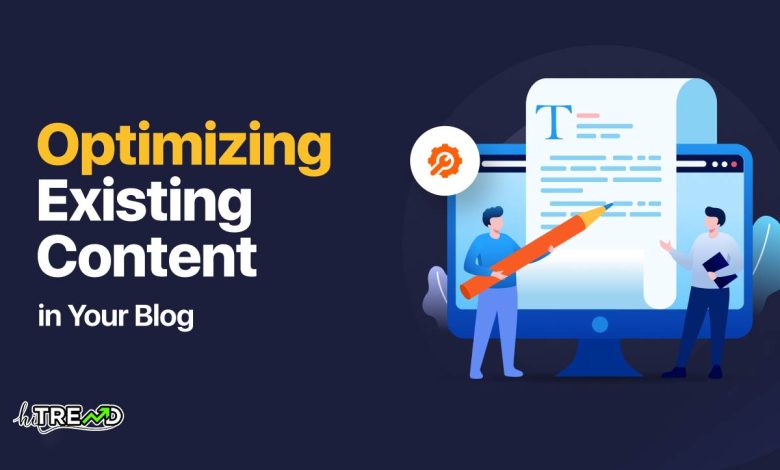How to Optimize Existing Content for SEO

Would you like to know how to optimize existing content for SEO?
If you have an existing website with a lot of content, optimizing that content for search engines is crucial for driving more organic traffic. Over time, search engine algorithms change, and content can become stale or less relevant. This is called content decay and can result in reduced visibility on search engine results pages (SERPs). It can also lead to a decline in organic traffic.
Optimizing existing content for search engine optimization (SEO) is crucial for improving your website’s visibility and driving more traffic to your site.
In this article, we will walk you through the steps to optimize your existing content for SEO and provide you with the best tools to help you achieve this goal.
You can read more Seo articles
What is Content Optimization?
Content optimization is the process of improving existing website content to make it more effective for SEO and user experience (UX). It involves analyzing and refining your content to ensure it is relevant, informative, and engaging for both search engines and your target audience.
While it may sound complicated and time-consuming, there are various content optimization tools you can use to make it easier. You can also follow our content optimization tips to ensure that your content:
Meets the current SEO best practices
Aligns with user intent
Remains up-to-date with industry trends (evergreen)
Well-optimized content can result in better search rankings and more traffic to your site, making it an essential component of every blog content strategy.
How to Optimize Existing Content for SEO
Ready to revitalize your content?
Here’s a step-by-step guide to help you know how to optimize existing content:
1. Use the Right SEO Content Optimization Tools
To optimize your SEO content, you need to use the right tools. And at AIOSEO, we have 2 such tools:
All In One SEO (AIOSEO)
SEOBoost
Here’s a brief summary of the content optimization capabilities of each:
Using AIOSEO for Content Optimization
One of the first tools to include in your content optimization toolbox is All In One SEO (AIOSEO). The plugin helps you optimize your content with a focus on SEO.
AIOSEO is a powerful WordPress SEO plugin boasting 3+ million active users. Many marketers and bloggers trust the plugin to help them boost their search engine rankings and traffic. That’s because the plugin has many powerful features and modules to help you properly configure your SEO settings.
When it comes to knowing how to optimize existing content, some of the modules you’ll find helpful include:
TruSEO Analysis
AIOSEO’s TruSEO On-page Analysis gives you a score of how well-optimized your content is.
It even gives you recommendations for improving it so your content is optimized for SEO.
TruSEO Highlighter
AIOSEO’s TruSEO Highlighter is a great tool that helps you nail your on-page SEO on the fly.
The TruSEO Highlighter analyzes your page content and makes readability recommendations. It highlights items that include:
Subheading distribution
Passive voice
Transition words
AIOSEO’s TruSEO gives you recommendations for fixing any on-page SEO errors it finds. This way, you can rest assured your content is optimized.
Link Assistant
Internal links play a huge role in content optimization. They help:
Distribute link juice
Improve crawling and indexing
Help keep readers on your site longer
This is where AIOSEO’s Link Assistant comes in.
Link Assistant is a tool that crawls your site and gives a report of all the links on your site.
Link Assistant gives you a Links Report that shows you internal linking suggestions and your site’s orphan pages.
The best part is that you don’t even need to open a post to add the links. You can just do so from the Link Assistant dashboard.
For step-by-step instructions on how to install AIOSEO, check our detailed installation guide.
SEOBoost: Full-suite Content Management Platform
Another content optimization tool to consider is SEOBoost.
SEOBoost is a full-suite content management platform you can use to:
Create content briefs and outlines
Create topic reports
Use AI to speed up content optimization
It also gives recommendations on how to better optimize your content before publishing.
The tool has a powerful content audit feature for optimizing existing content for SEO. Simply input the URL of the page you want to audit, and SEOBoost will analyze it for you and recommend improvements.
Once the audit is complete and you’ve analyzed the data, click the Optimize Content button.
This will take you to a page where you can use the content audit results to optimize your content.
Check out the full power of SEOBoost here.
2. Identify the Content that Needs Updating
The next step in learning how to optimize existing content for SEO is to identify the content that needs updating. In most cases, this content is decaying or losing traffic and relevance over time. AIOSEO’s Search Statistics module, our Google Search Console integration, can easily identify this content.
Search Statistics is designed to help you track and monitor your content and keyword performance in your WordPress dashboard. This means you don’t have to turn to tools like Google Analytics (GA4), Semrush, or other tools.
Regarding spotting content decay, you can use 2 reports in Search Statistics: the Content Performance report and the Keyword Rankings report. So, let’s dive into how these 2 can help you spot content decay.
The Content Performance Report
The Content Performance report provides insights into how your content is performing on SERPs. It provides an overview of all your content and a deep dive into your losing and winning content.
In this case, we’ll want to focus on the Top Losing tab, which shows the content slipping in rankings.
In many cases, this decline is a result of content decay.
The Keyword Rankings Report
The Keyword Rankings report focuses more on how your keywords are performing in search.
This report shows you which keywords are gaining momentum on SERPs and those that are tanking.
Again, to spot content decay, we’ll want to focus on those that are declining in rankings.
Monitor Impressions
Besides the Content Performance and Keyword Rankings reports, you can also monitor the Impressions tab.
Impressions refer to the number of times users on SERPs see your search listing. A decline in Impressions indicates that fewer people can see your search listing. This is usually a result of dropping in rankings—a sign of content decay.
Check for Dips in Clickthrough Rates (CTR)
Organic clickthrough rates (CTR) indicate the percentage of people who click on your search listing on SERPs. Again, you can check this critical metric using AIOSEO’s Search Statistics module.
Keeping tabs on your CTRs is essential to monitoring content decay and identifying existing content that needs to be optimized for SEO.
3. Run a Content Audit Report
A content audit systematically analyzes your content to assess its quality, performance, and relevance to the target audience. It helps identify which content to keep, remove, or optimize. This is essential in knowing how to optimize existing content for SEO.
One tool that can help you run SEO audits without needing any technical knowledge is SEOBoost. It’s so easy. All you have to do is input the URL of the page you want to audit.
SEOBoost will analyze it for you and recommend improvements you can make to optimize the page. Once the audit is complete and you’ve analyzed the data, click the Optimize Content button.
This will take you to a page where you can use the content audit results to optimize your content.
You can take your content audit a step further by finding low-difficulty keywords to add to your content. A tool like LowFruits makes this easy.
LowFruits is another tool to add to your list of the best SEO rank trackers. It’s a revolutionary keyword research tool designed to help you unearth low-competition keywords to skyrocket your SEO.
LowFruits identifies weak spots in the SERPs, allowing you to target keywords with a higher chance of ranking. These can help optimize your existing content to rank for more keywords, resulting in better search rankings and more traffic.
4. Optimize Your Content
Armed with the content audit report data, you can now take the next step in optimizing your existing content. Remember, the main essence of content optimization is to get your on-page SEO right. SEOBoost helps by showing you many on-page SEO elements you can optimize on your page.
For example, SEOBoost helps ensure you:
Meet the right word count
Ensure your content is scannable and has a good readability score
Optimal keyword usage
Proper image use
And more
Using tools like SEOBoosts is the fastest way to ensure your content is primed to meet the on-page SEO standards for your target keyword. That’s why this tool is invaluable if you seriously want to know how to optimize existing content for SEO.
5. Update Internal Links and Metadata
An integral part of optimizing existing content is updating associated links and metadata. Broken links, outdated meta descriptions, and inaccurate SEO titles can harm your site’s usability and search engine rankings. You should also consider linking to newer content and having that newer content link to the page you’re optimizing.
Here’s how you can easily optimize these elements without breaking a sweat:
Add Relevant Internal Links with AIOSEO
Use AIOSEO’s link assistant to optimize links and find new linking opportunities. This will help signal to search engines the relevance of that page. Link Assistant also helps you find and fix orphan pages.
Leverage AI to Generate Metadata Fast and at Scale
Particularly if you publish many pages, crafting SEO-friendly title tags and meta descriptions can take up a lot of time. That’s why you should speed this process up with an AI-powered tool. AIOSEO’s AI Title/Description Generator makes this easy, as you don’t even have to leave your WordPress dashboard.
Simply click on the version you want to use, and you’ll have your meta description or title tag with the click of a button. This will help speed up the content optimization process, giving you time for other tasks.
For detailed steps on using this powerful tool, check out our tutorial on using a meta description generator in WordPress.
Maintaining accurate and up-to-date links and metadata enhances the user experience and improves your site’s visibility. Despite significantly impacting your content, it’s one of the most often overlooked content optimization tips.
6. Find and Fix Broken Links
Broken links create a frustrating user experience and can hurt your SEO performance in several ways. From a user experience standpoint, running into dead links disrupts the content flow and can cause visitors to quickly abandon your site. Search engines also look negatively upon sites with many broken links, which signals poor site maintenance and quality issues.
This is why, if you want to know how to optimize existing content, fixing broken links must be a part of your strategy.
To easily find and fix broken links, use tools like Broken Link Checker.
This is a powerful tool that crawls your site and identifies broken links. With a click of a button, you can easily fix them.
Follow HiTrend on X





